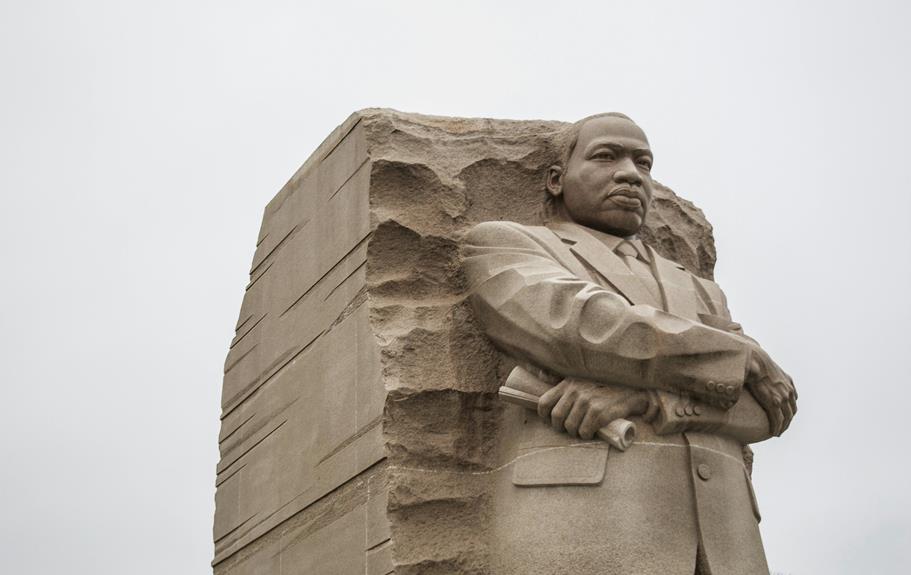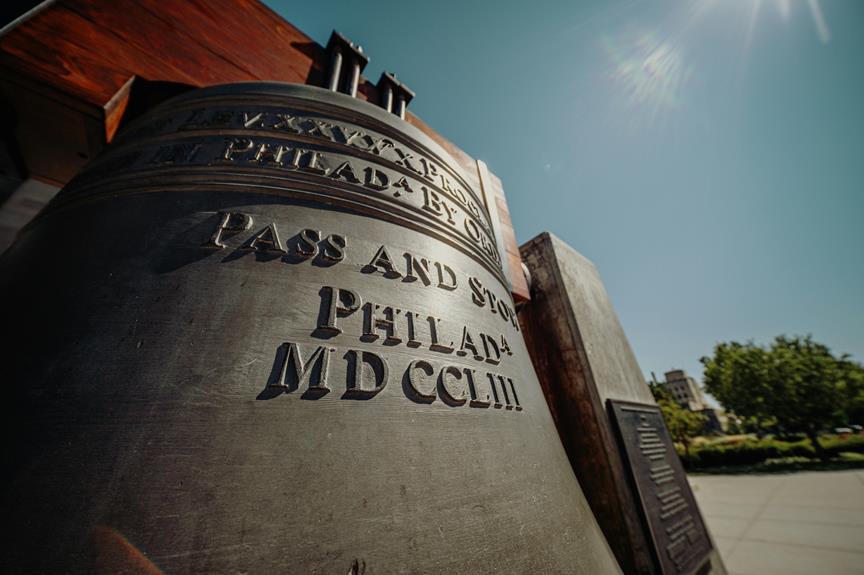The National WWII Memorial in the USA stands as a solemn testimony to the sacrifices made during one of the most pivotal periods in modern history. With its intricate design elements and profound symbolism, this memorial offers a profound reflection on the impact of World War II and the resilience of the human spirit in times of crisis. As visitors walk through the memorial, they are transported back in time, surrounded by reminders of the bravery and dedication that defined a generation. But what lies beneath the surface of this iconic landmark goes beyond mere symbolism; it is a gateway to a deeper understanding of our shared history and a tribute to the enduring legacy of those who served.
Key Takeaways
- Symbolizes WWII sacrifices and courage.
- Features granite pillars, bronze wreaths, and a central plaza.
- Honors fallen soldiers with 4,048 gold stars.
- Open 24/7 with no entrance fees.
- Offers educational programs and interactive exhibits.
History and Significance
The National WWII Memorial in the United States stands as a solemn tribute to the historical significance of World War II and the sacrifices made by millions during the global conflict. The importance of this memorial lies in its role as a symbol of remembrance for the brave men and women who served their country during one of the most tumultuous times in modern history. World War II had a profound impact on nations across the globe, shaping the course of history and redefining the meaning of freedom for generations to come.
This memorial serves as a poignant reminder of the tremendous sacrifices made by both military personnel and civilians during the war. It honors the resilience and courage displayed by individuals in the face of unimaginable adversity. The impact of World War II reverberates to this day, influencing international relations, political dynamics, and societal norms.
Architectural Features
Embodying a blend of classical and contemporary architectural elements, the National WWII Memorial in the United States stands as a striking tribute to the monumental events of World War II. The memorial is characterized by its structural details and artistic elements that evoke a sense of grandeur and solemnity.
The architectural features of the National WWII Memorial are meticulously designed to convey the gravity of the war's impact. The memorial consists of 56 granite pillars arranged in two semicircles, representing the states and territories that participated in the war. These pillars are adorned with bronze wreaths and oak laurel to symbolize victory and valor. The central plaza features a large pool with fountains, surrounded by sculptural reliefs depicting scenes from the war.
One of the most striking architectural elements of the memorial is the Freedom Wall, which is lined with 4,048 gold stars, each representing 100 American soldiers who lost their lives during the war. This poignant tribute serves as a powerful reminder of the sacrifices made by the brave men and women who served their country.
Symbolism and Design
With meticulous attention to detail and profound reverence, the symbolism and design of the National WWII Memorial intricately weave together a narrative of honor and remembrance for the sacrifices of those who served during World War II. The symbolism exploration within the memorial is evident in its architectural elements. The two arches on the north and south sides represent the Atlantic and Pacific theaters of the war. The Freedom Wall adorned with 4,048 gold stars honors the over 400,000 Americans who lost their lives in the conflict. These design choices serve as a poignant reminder of the immense scale of sacrifice during WWII.
Design analysis reveals a deliberate effort to create a space that encourages reflection and contemplation. The memorial's central point is the Rainbow Pool, symbolizing unity and the overall victory of freedom over tyranny. The surrounding granite pillars and bronze wreaths signify the states and territories involved in the war effort, fostering a sense of national unity and collective remembrance. The water features not only provide a sense of tranquility but also symbolize the vast oceans crossed by troops during the war.
Commemorative Elements
Interwoven within the National WWII Memorial are carefully curated commemorative elements that pay homage to the diverse contributions and sacrifices made by individuals and communities during World War II.
- Veterans' Stories: The memorial features poignant exhibitions that showcase the personal narratives of veterans who served during World War II. These stories provide visitors with a firsthand account of the challenges, triumphs, and sacrifices experienced by those who fought in the war, guaranteeing that their memories live on for future generations.
- Preservation Efforts: Conservation initiatives are integral to maintaining the integrity and historical significance of the commemorative elements at the National WWII Memorial. Through ongoing conservation projects and educational programs, efforts are made to safeguard and honor the legacy of those who served, ensuring that their contributions are never forgotten.
- Public Art: A key component of the memorial's commemorative elements is the incorporation of public art installations that capture the spirit and resilience of the wartime era. These artistic expressions serve as powerful reminders of the courage and unity that defined the World War II generation, inspiring reflection and reverence among visitors.
- Fundraising Initiatives: To support the maintenance and enhancement of the memorial's commemorative elements, fundraising initiatives are organized to engage the public in contributing to its preservation. These efforts not only guarantee the continued upkeep of the memorial but also foster a sense of collective responsibility for honoring the sacrifices of those who served during World War II.
Visiting Information
Visitors to the National WWII Memorial in the United States can access essential information regarding their visit, including operating hours, accessibility options, and notable features to explore. The memorial is open to the public 24 hours a day, seven days a week, allowing visitors the flexibility to pay their respects and explore the site at their convenience. There are no entrance requirements or fees to visit the memorial, making it accessible to all who wish to honor the legacy of those who served during World War II.
In terms of accessibility, the National WWII Memorial offers ramps and designated parking for individuals with disabilities, guaranteeing that all visitors can navigate the memorial with ease. Additionally, there are informational plaques and braille inscriptions throughout the site to accommodate visitors with visual impairments.
Parking options near the memorial include street parking and several nearby parking garages for those arriving by car. Visitors are encouraged to check for any parking restrictions or fees before their visit to ensure a smooth experience. Alternatively, the memorial is easily accessible via public transportation, with bus stops and metro stations in close proximity for those utilizing these services. Whether arriving by car, bus, or metro, visitors will find convenient options for reaching this significant historical site.
Events and Ceremonies
- Veterans Reunions:
One of the most important events held at the National WWII Memorial is veterans reunions. These gatherings provide an opportunity for veterans of World War II to reunite, share their experiences, and pay tribute to their fallen comrades. It is a time of reflection, camaraderie, and honoring the sacrifices made during the war.
- Memorial Day:
Memorial Day is a solemn occasion observed at the National WWII Memorial to honor and remember the servicemen and women who lost their lives during World War II. The day typically involves ceremonies, wreath laying, and speeches to commemorate the bravery and sacrifice of those who fought in the war.
- Honor Guards:
Honor guards play an essential role in many ceremonies held at the memorial. These dedicated individuals perform ceremonial duties such as flag-raising, wreath laying, and standing guard to honor the memory of those who served during World War II.
- Wreath Laying:
Wreath laying ceremonies are a common sight at the National WWII Memorial. These ceremonies involve the laying of wreaths at the memorial to pay tribute to the fallen soldiers and to symbolize remembrance and honor for their service and sacrifice.
Educational Resources
Numerous educational resources are available at the National WWII Memorial in the United States, offering visitors a deeper understanding of the historical significance and impact of World War II. One of the key educational tools provided is a range of online resources accessible through the memorial's website. These resources include historical articles, virtual tours, interactive maps, and archival photographs, allowing individuals to explore the intricacies of the war from anywhere in the world.
In addition to online resources, the memorial features interactive exhibits on-site that engage visitors in a hands-on learning experience. These exhibits showcase artifacts from the war, multimedia displays, and oral histories of veterans, providing a tangible connection to the past. Visitors can investigate the different theaters of the war, learn about key battles and strategies, and gain insight into the personal stories of those who served.
Moreover, educational programs such as guided tours, lectures, and workshops are offered regularly at the memorial to further enhance visitors' knowledge and understanding of World War II. These programs are designed to cater to individuals of all ages and backgrounds, ensuring that the educational resources available are accessible and engaging for everyone interested in learning about this pivotal period in history.
Ways to Support
Support for the National WWII Memorial can be demonstrated through various means, each contributing to the preservation and commemoration of this significant historical site. Here are four impactful ways to support the National WWII Memorial:
- Fundraising Initiatives: Donating to fundraising campaigns dedicated to the upkeep and enhancement of the National WWII Memorial is an essential way to show support. These initiatives help maintain the memorial, ensuring it remains a fitting tribute to those who served during World War II.
- Volunteer Opportunities: Engaging in volunteer work at the memorial provides hands-on support. Volunteers can assist with guided tours, help visitors navigate the site, or participate in maintenance tasks. This direct involvement fosters a sense of community and shared responsibility for preserving this important landmark.
- Sponsorship Programs: Many organizations offer sponsorship programs that allow individuals or businesses to contribute to specific projects or events at the memorial. By becoming a sponsor, you can support targeted initiatives that align with your interests and values.
- Awareness Campaigns: Sharing information about the National WWII Memorial through social media, community events, or educational programs raises awareness and interest in this historic site. By spreading the word, you can encourage others to support and engage with the memorial, ensuring its legacy endures for future generations.
Frequently Asked Questions
Can Visitors Touch the WWII Memorial's Bronze Wreaths?
Visitors' etiquette plays an essential role in memorial preservation. When considering the bronze wreaths at a memorial site, it is generally advisable for visitors to refrain from touching them. Physical contact can lead to wear and tear, potentially compromising the integrity of these significant elements.
Respecting the memorial's design and materials helps guarantee that future generations can also appreciate its historical significance. It is important to be mindful of the impact our actions may have on these important sites.
Are Drones Allowed Near the National WWII Memorial?
When considering drone photography near memorials, it is important to prioritize memorial privacy and respect. Federal regulations often prohibit drone flights over certain areas, including memorials, due to safety concerns, privacy considerations, and the potential disruption to visitors.
Therefore, it is recommended to check with local authorities and adhere to any specific guidelines or restrictions in place to make sure that drone operations do not interfere with the sanctity and solemnity of memorial spaces.
Is There a Specific Dress Code for Visiting?
When visiting a memorial, it is important to uphold a respectful dress code and maintain proper memorial etiquette. Dressing appropriately demonstrates reverence for the significance of the site and those being commemorated. While specific dress codes may vary, it is generally recommended to wear modest and respectful attire.
Following memorial etiquette, such as maintaining a quiet demeanor and refraining from disruptive behavior, guarantees a solemn and respectful atmosphere for all visitors.
Are There Any Age Restrictions for Visiting the Memorial?
Age restrictions are not typically imposed on visitors to memorials. However, it is essential to adhere to memorial etiquette and show respect when visiting such sites. This includes maintaining a solemn and respectful demeanor, refraining from disruptive behavior, and following any specific rules or guidelines outlined at the memorial.
Visitors of all ages are encouraged to learn about the historical significance of the memorial and pay their respects accordingly.
Can Visitors Bring Their Pets to the Memorial Site?
Pet owners visiting memorials should always be mindful of proper memorial etiquette. While pets are allowed in some outdoor spaces, it is important to respect the solemnity of such sites.
Visitors should check specific rules and regulations regarding pets at each location to make sure they comply with any restrictions. Maintaining a respectful attitude towards the memorial and its significance is paramount when deciding whether to bring a pet to such a place.
Conclusion
To sum up, the National WWII Memorial stands as a timeless beacon of courage and sacrifice, a tribute to the resilience and valor of those who served during World War II.
Like a granite fortress of remembrance, it stands steadfast in honoring the fallen soldiers and ensuring that their stories are never forgotten.
As the waters of time flow around it, the memorial remains a symbol of the enduring impact of the war on history and humanity.


